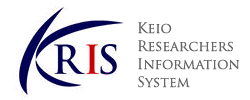-
Affiliation
-
School of Medicine, Department of Internal Medicine (Rheumatology) ( Shinanomachi )
-
Position
-
Researcher (Non-tenured) / Project Researcher(Non-tenured)

KEIO RESEARCHERS INFORMATION SYSTEM |
Details of a Researcher
このページはJavascriptを使用しています。すべての機能を使用するためにはJavascript を有効にする必要があります。
Yoshimoto, Keiko
|
|
|
School of Medicine, 内科学(リウマチ・膠原病), Research Associate
BAFF receptor (BR3)
B cell
B cell stimulationg factor (BAFF)
Sjogren's syndrome
systemic lupus erythematosus
シェーグレン症候群の病態解析とBAFF受容体を標的としたSS治療薬の探索研究,
SLEおよびシェーグレン症候群(SS)の病態におけるB細胞活性化因子(BAFF)の関与に関する病態解析研究,
全身性エリテマトーデス患者末梢血T細胞におけるT細胞受容体(TCR)の発現低下が及ぼすT細胞の機能異常に関する病態解析研究,
Akiyama M., Wakasugi S., Yoshimoto K., Saito K., Ishigaki S., Inukai R., Matsuno Y., Alshehri W., Kondo Y., Kaneko Y.
Inflammation and Regeneration 45 ( 1 ) 2025.12
Inukai R., Akiyama M., Yoshimoto K., Wakasugi S., Matsuno Y., Ishigaki S., Alshehri W., Saito K., Kaneko Y.
Clinical and Experimental Rheumatology 43 ( 4 ) 630 - 635 2025.04
ISSN 0392856X
CCR4+Tfh2 cells specifically produce IL-4 driving the pathological reaction in IgG4-related disease
Akiyama M., Yoshimoto K., Yasuoka H., Ishigaki S., Takanashi S., Takeuchi T., Kaneko Y.
Clinical and Experimental Rheumatology 43 ( 3 ) 435 - 443 2025.03
ISSN 0392856X
Tamai H., Ikeda K., Miyamoto T., Taguchi H., Kuo C.F., Shin K., Hirata S., Okano Y., Sato S., Yasuoka H., Kuwana M., Ishii T., Kameda H., Kojima T., Nishi Y., Mori M., Miyagishi H., Toshima G., Sato Y., Tsai W.C., Takeuchi T., Kaneko Y., Izumi K., Kondo Y., Yoshimoto K., Gono T., Park S.H., Baek H.J., Lee Y.J., Choi I.A., Kim J., Hsu P.N., Huang C.M., Weng M.Y., Sung W.Y., Cheng T.T.
Annals of the Rheumatic Diseases 84 ( 1 ) 41 - 48 2025.01
ISSN 00034967
Seki N., Tsujimoto H., Tanemura S., Kojima S., Miyoshi F., Kikuchi J., Saito S., Akiyama M., Sugahara K., Yoshimoto K., Kaneko Y., Chiba K., Takeuchi T.
Communications Biology (Communications Biology) 7 ( 1 ) 2024.12
Akiyama M., Yasuoka H., Yoshimoto K., Takeuchi T.
Annals of the Rheumatic Diseases (Annals of the Rheumatic Diseases) 77 ( 9 ) 1386 - 1387 2018.09
ISSN 00034967
Possible involvement of the voltage-gated sodium channel 1.7 in activation of BAFF signaling in monocytes of patients with primary Sjögren’s syndrome.
Keiko Yoshimoto, Katsuya Suzuki, Yumi Ikeda, Eriko Takei, Tsutomu Takeuchi
[Domestic presentation] The 50th annual meeting of Japanese Society for Immunology ,
Poster presentation
Signal transduction via BAFF receptor, BR3, is involved in activation of monocytes through NF-kB pathways in primary Sjögren’s syndrome.
Keiko Yoshimoto, Katsuya Suzuki, Yumi Ikeda, Eriko Takei, Tsutomu Takeuchi
[International presentation] APLAR 2021,
Oral presentation (general)
The crosstalk between BAFF-signaling and sodium channel is involved in activation of monocytes of patients with primary Sjogren’s syndrome.
Keiko Yoshimoto, Katsuya Suzuki, Yumi Ikeda, Eriko Takei, Tsutomu Takeuchi
[Domestic presentation] 第65回日本リウマチ学会総会・学術集会,
Oral presentation (general)
Possible involvement of Fractalkine/CX3CR1 axis in peripheral CD14++CD16+ monocytes in disease development of patients with systemic lupus erythematosus.
Keiko Yoshimoto, Katsuya Suzuki, Noriyasu Seki, Shuntaro Saito, Jun Kikuchi, Tsutomu Takeuchi
[International presentation] ACR 2020,
Oral presentation (general)
Elevated expression of BAFF receptor, BR3, in peripheral monocytes is involved in B cell activation and clinical features of patients with primary Sjögren’s syndrome.
Keiko Yoshimoto, Katsuya Suzuki, Eriko Takei, Yumi Ikeda, Tsutomu Takeuchi
[Domestic presentation] 第64回日本リウマチ学会総会・学術集会,
Oral presentation (general)
B細胞機能制御作用を有する低分子化合物を用いたSLE新規治療標的分子の探索
MEXT,JSPS, Grant-in-Aid for Scientific Research, 基盤研究(C), Principal investigator
Elucidation of the regulatory mechanisms of the crosstalk between BAFF signaling and Nav channel in monocytes aiming at development of radical therapy for Sjögrens syndrome.
MEXT,JSPS, Grant-in-Aid for Scientific Research, Grant-in-Aid for Scientific Research (C), Principal investigator
炎症性疾患の予防及び/又は治療剤
Date applied: JP2015541587A 2014.10
Patent, Joint
ピロロピリミジン誘導体を有効成分とするBAFFの結合阻害剤
Date applied: JP2010266369A 2010.11
Date issued: JP5628647B2 2014.11
Patent, Joint
BAFF抑制剤又は阻害剤のスクリーニング法
Date applied: JP2006535161A 2005.09
Date issued: JP4907353B2 2012.03
Patent, Joint
BAFF抑制剤又は阻害剤のスクリーニング法
Date applied: US11662795 2005.09
Date issued: US8017329B2 2011.09
Patent, Joint
BAFF抑制剤又は阻害剤のスクリーニング法
Date applied: EP20050783483 2005.09
Date issued: EP1801231B1 2011.11
Patent, Joint
第34回日本臨床免疫学会総会 優秀演題賞
吉本桂子, 2006.10, 日本臨床免疫学会, ヒトT細胞BAFF産生制御機構におけるMMPの関与
第41回日本臨床免疫学会総会 優秀演題賞
吉本桂子, 2013.11, 日本臨床免疫学会, B細胞活性化因子(BAFF)による末梢単球活性化機構にはNF-kB経路が関与している
第35回日本炎症再生医学会総会 優秀演題賞
吉本桂子, 2014.07, 日本再生医学会, 一次性シェーグレン症候群患者末梢単球機能異常の抗体産生機構への関与
第27回日本シェーグレン症候群学会学術集会優秀演題賞
吉本桂子, 2018.09, 日本シェーグレン症候群学会, 原発性シェーグレン症候群患者末梢血単球活性化におけるBAFFとMMP-9の関与
第27回日本シェーグレン症候群学会学術集会優秀演題賞
吉本桂子, 2018.09, 日本シェーグレン症候群学会, 原発性シェーグレン症候群患者末梢血単球活性化におけるBAFFとMMP-9の関与
The Japanese Society of Inflammation and Regeneration,
Japanese Society for Clinical Immunology,
American Society of Immunologists,
Japan College of Rheumatology,
Japanese Society for Immunology,